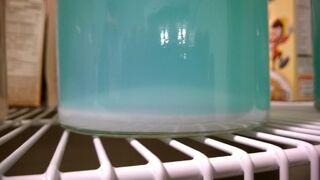
Typical sediment seen with guar gum/baking powder-based mixes.
Due to the nature of guar gum, bubble juice made with guar gum typically has a layer of sediment that forms at the bottom over time. A certain amount of sediment is not a problem and cannot be eliminated -- even with 24 hours of stirring with a laboratory magnetic stirrer and distilled water. A team of Wiki members spent a great deal of time over a period of a month to see if we could eliminate the sediment when using the type of guar gum powders readily available. It became clear that the sediment is a normal occurrence and the hoops we jumped through to minimize it made no difference in how well the juice worked, as long as we avoided the formation of real "sludge" or a discrete gel disk (see below). Real "sludge" and the gel disk will not form if you follow the recipes provided on the Wiki.
The amount of sediment is variable and influenced by a number of factors such as particulate matter in the water, and the juice ingredients.
Flocculant. Guar gum is a natural flocculant that traps particles suspended in the water -- including the small amount of ground guar husk that is normally found in guar gum. It will also trap the insoluble corn starch found in baking power and any other particles suspended in the water.
Sediment Example[]
The video below demonstrates perfectly normal sediment. This is not the dreaded "sludge" although the author that posted the video was not aware of this at the time.

Guar Based Bubble Solution - Sludge experiment 1 - Shaking Tap Water Solution
Sediment vs. Sludge vs. Gel Disk[]
There are cases where a "sludge" layer or discrete gel disk will form over time. These are distinct from the sort of sediment shown above. In the sediment video (the video's creator mistakenly believed he was seeing "sludge"), you will notice that the sediment moves easily when shaken. Even light shaking reveals that this sediment has a cloud-like nature. True sludge is a heavier layer that does not display the wispy, cloud-like character of the sediment you see in the video.
Inadvertently, when experimenting early on, we ended up with a couple of batches that had sludge. Those batches all used several times the amount of guar gum called for in the recipes on the Wiki.
When trying to make concentrates, we found that the guar would fall out of the solution into a discrete gel disk that became more and more discrete as time went on. Such gel disks won't incorporate back into the water -- even if you add a very large amount of water and use mechanical stirring. Insufficient available water during hydration leads to this condition. The concentration at which it happens is influenced by both the water/detergent ratio and other ingredients. Baking soda, for instance, encourages the disk formation.
See Also[]
Wiki member SpaceCaseChris did some experiments in 2015 to see if there was a relationship between sediment/sludge and hard water. We were edified to see that his findings supported the Wiki team's original findings that sediment was impossible to eliminate, and that water quality seems not to be a factor. Using distilled water did not reduce the amount of sediment -- nor did arduous stirring over extended time.
You can see his related articles:
Please note that what he calls "sludge" in his blog posts is actually the normally occurring sediment. Not the dreaded sludge.